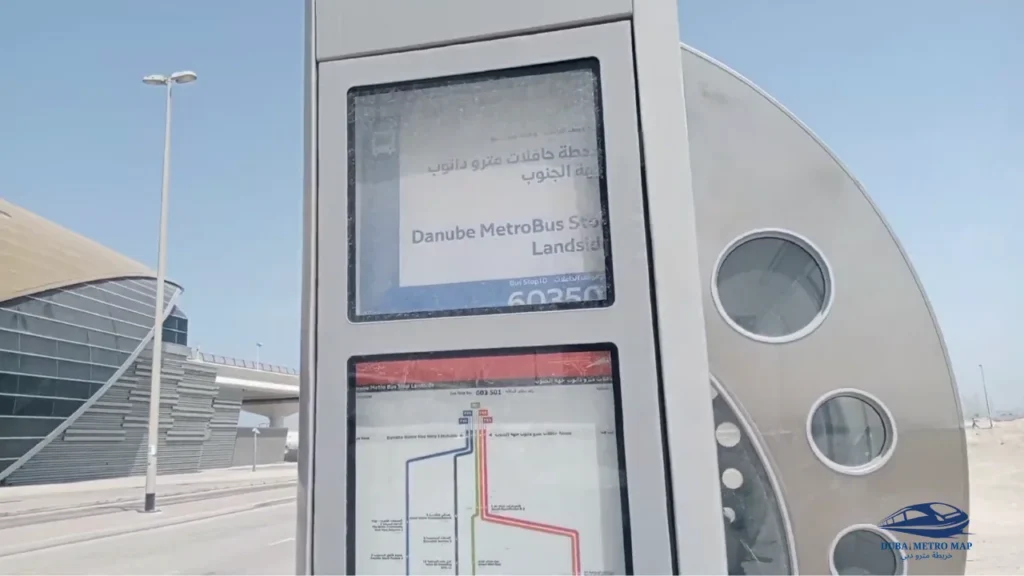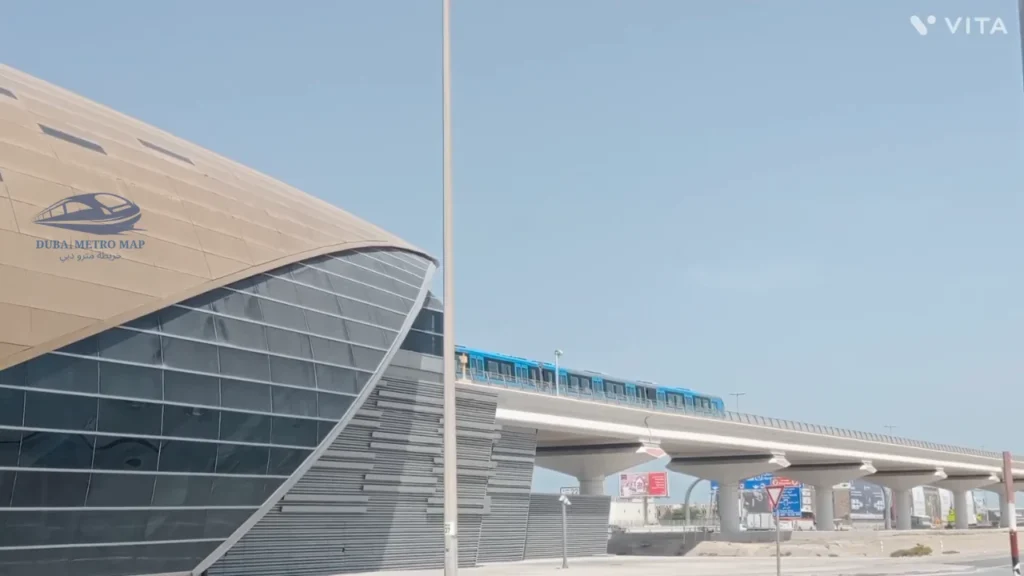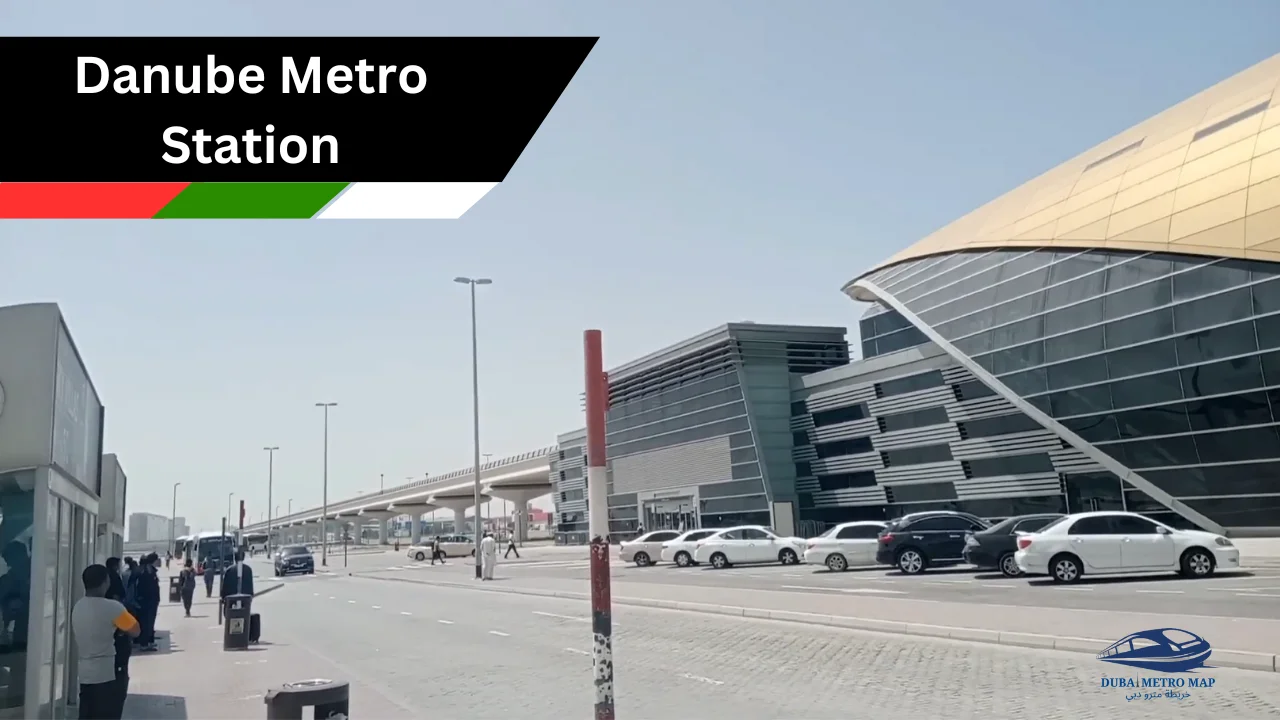Danube Metro Station, located on the Red Line of the Dubai Metro, serves the Jebel Ali area and its surroundings. It was officially opened on December 12, 2012, as part of the 10 new Red Line stations.
Positioned on Sheikh Zayed Road, between the D57 and E77 junctions, the station is conveniently located near several bus stops, making it a hub for easy commuting. To the west lies Mina Jabal Ali, a notable landmark close to the station.
- Location and Accessibility
- History and Development
- Facilities and Features
- Role in the Metro Network
- Community Impact of Danube Metro Station
- Future Developments of Danube Metro Station
- Accommodation & Hotels Near Danube Metro Station
- Danube Metro Station Exit
- Travel Time of Danube Metro Station
- Frequently Asked Questions
- Conclusion
Location and Accessibility
Geographic Location of the Station
The Danube Metro Station is in the northeast part of Paris, France, within the 19th arrondissement. It operates on Line 7bis of the Paris Métro and derives its name from the nearby Place du Danube and the iconic Danube River, which flows through much of Central and Eastern Europe.
Strategically placed at the intersection of Rue de Crimée and Rue du Rhin, the station sits in Buttes-Beaumont, close to Parc des Buttes-Chaumont, one of Paris’s largest public parks.

Access Points
The access points of Danube Metro Stations vary depending on the city and context. Here’s a glimpse of typical features based on Vienna’s U-Bahn system (U2 line):
- Elevators and Escalators: Accessibility is a key focus, with elevators and escalators ensuring smooth entry and exit.
- Entrances and Exits: Strategically designed to connect passengers to nearby transport networks and city hotspots.
- Ticketing Facilities: Ticket kiosks provide options for single journeys or daily passes.
- Public Transport Links: Close connections to buses and trams are available, making it a vital part of the city’s transport system.
- Bike and Car Parking: Stations often feature bike racks and parking spaces to encourage eco-friendly commuting.
History and Development
Early Planning
The development of the Danube Metro Station reflects its city’s growth and transportation needs. Being near the Danube River, the station’s planning had to address:
- Urban Growth: Meeting the demands of densely populated riverside areas.
- Geological and Hydrological Concerns: Addressing terrain stability, water levels, and potential flooding.
- Integration with Transport Networks: Ensuring smooth connections with trams, buses, and other transit systems.
- Strategic Importance: Serving as a link to key tourist attractions, business hubs, and residential neighborhoods.
Construction Challenges
Building a metro station near a major river like the Danube involves tackling engineering and environmental complexities. For example, Vienna’s stations along the U2 line, such as Donaustadt and Donaumarina, highlight the scale of such projects. Key steps include:
- Pre-Construction Studies: Feasibility, geotechnical, and environmental assessments.
- Waterproofing Techniques: Using reinforced concrete, waterproof membranes, and flood protection systems.
- Excavation and Tunnel Boring: Utilizing advanced tunnel boring machines to minimize impact on the riverbed and surrounding infrastructure.
- Structural Reinforcement: Implementing concrete slabs, steel beams, and ventilation systems for safety and durability.
Facilities and Features
The Danube Metro Station offers a variety of modern facilities, ensuring a seamless experience for commuters. These include:
- Accessibility Features: Elevators, ramps, escalators, and tactile guidance systems.
- Ticketing and Information: Automated ticket machines, help desks, real-time information panels, and clear signage.
- Safety and Security: CCTV cameras, emergency call points, fire safety systems, and extensive lighting.
- Platform Amenities: Spacious platforms, benches, screen doors, and voice announcements for convenience.
- Transport Connectivity: Easy access to buses, trams, bike stands, and car parking.

Role in the Metro Network
Danube Metro Stations are pivotal in connecting riverfront regions to key parts of the city. They facilitate:
- Seamless Commuting: Linking commercial hubs with residential areas.
- Multimodal Transport: Serving as interchange points for buses, trams, and ferries.
- Tourism: Providing access to landmarks, parks, and recreational spaces.
- Urban Development: Encouraging real estate growth and business opportunities in riverside districts.
Community Impact of Danube Metro Station
Danube Metro Stations, located in cities like Vienna, Budapest, and Bucharest, have a significant impact on local communities. These stations not only transform the ambiance of surrounding neighborhoods but also support economic development and improve the quality of life for residents. Below are some of the key ways these stations influence the local community:
1. Improved Mobility and Accessibility
- Enhancing Connectivity: Danube Metro Stations bridge different parts of the city, often connecting areas separated by the river. This improved connectivity makes it easier for residents to access employment centers, educational institutions, and healthcare facilities.
- Accessible for All: These stations are designed with inclusivity in mind, featuring elevators, ramps, and tactile paving to accommodate the elderly, people with disabilities, and families with strollers. This creates a more inclusive urban environment.
2. Local Economic Impact
- Increased Foot Traffic: The areas around these stations often see higher footfall, driving demand for retail stores, restaurants, and cafés. This boost supports small businesses and attracts commercial investments.
- Rising Property Values: Proximity to metro services tends to increase property values, making neighborhoods more attractive for residential and commercial development. For instance, areas near Danube Metro Stations in Vienna, like Donaustadt, have seen heightened real estate activity.
3. Urban Development Catalyst
- Riverside Revitalization: Metro stations along the Danube play a key role in regenerating riverside areas, often transforming industrial or underused zones into vibrant residential and commercial districts. A notable example is Vienna’s Donau City, which became more accessible with the metro expansion.
4. Reduction of Traffic Congestion and Pollution
- Shift to Public Transit: By offering a reliable alternative to driving, Danube Metro Stations help reduce traffic congestion in riverside neighborhoods and on bridges. This shift also lowers air pollution levels, benefiting the environment and public health.
5. Improved Quality of Life
- Access to Recreation: Being near the Danube, these stations provide residents with convenient access to parks, bike paths, and cultural spaces. For example, Vienna’s stations like Donaumarina and Donaustadtbrücke are close to the Donauinsel, a hub for water sports, fairs, and green spaces.
6. Job Creation and Economic Opportunities
- Employment Opportunities: The construction, operation, and maintenance of these stations generate jobs for locals. Additionally, increased economic activity in these areas creates a multiplier effect, boosting employment in retail, hospitality, and other services.
- Attracting Businesses: Improved transit options make riverside districts more appealing for businesses, especially those needing a large workforce. In Vienna, for instance, Donau City has become a hub for multinational corporations, supported by metro connectivity.
7. Environmental Sustainability and Resilience
- Flood Protection: Due to their proximity to the Danube, these metro stations are equipped with flood management infrastructure, which not only protects the stations but also benefits nearby homes and businesses by enhancing flood resilience.
Future Developments of Danube Metro Station
Looking ahead, Danube Metro Stations are poised for modernization to meet the growing needs of cities like Vienna, Budapest, and Bucharest. Upcoming improvements will emphasize sustainability, connectivity, and advanced technology, ensuring these stations remain at the forefront of urban transportation.
1. Sustainability and Green Initiatives
- Energy-Efficient Designs: Future stations could incorporate energy-efficient materials and systems, like energy-recapturing technologies that convert the kinetic energy from braking trains into usable power.
- Green Roofs and Walls: Integrating green roofs and walls can help reduce heat, absorb pollutants, and enhance urban biodiversity.
2. Integration of Smart Technology
- Smart Ticketing: Advanced systems will allow for mobile-based, contactless payments using apps, QR codes, or even biometric scans like facial recognition.
- Smart Lighting and Climate Control: IoT-enabled systems could manage lighting and climate control, adapting to passenger load, time of day, and weather conditions to ensure comfort and save energy.
3. Increased Connectivity and Urban Integration
- Autonomous Vehicles: Future stations may integrate with self-driving buses or shared electric vehicles, creating seamless transitions between metro services and autonomous transport.
- River Transport Integration: Connecting metro stations with river ferries or water taxis could create a more cohesive transport system along the Danube.
4. Accessibility for All
- Enhanced Features: AI-directed navigation, voice-activated elevators, and tactile surfaces could further improve accessibility for visually impaired passengers and others.
- Inclusive Design: Wider platforms, more seating, and clearer signage will ensure metro stations cater to a diverse user base, including elderly individuals and parents with infants.
5. Urban Revitalization and New Public Spaces
- Public Plazas and Green Spaces: Future stations could include parks, plazas, and community spaces, transforming them into lively hubs for recreation, socialization, and cultural events.
- Art and Cultural Spaces: Metro stations could serve as venues for public art, exhibitions, and performances, turning them into cultural landmarks.
6. Intelligent Safety and Security
- Advanced Flood Protection: Sophisticated systems like improved drainage, advanced flood barriers, and floating platforms could address the challenges of rising water levels.
- Health and Safety Protocols: Air filtration systems and touchless technologies will create a safer commuting environment by reducing the risk of spreading viruses.
Accommodation & Hotels Near Danube Metro Station
| Hotels | Location | Exit |
| Join Inn Hotel Jebel Ali | JAFZA Food Court 1 – Street 724 | 2 |
| Expo Backpackers | 601, Building – 158 – Metro Station | 2 |
| Parkside Hotel Apartment LLC | Street no.1 building no.12 | 2 |
| Premier Inn Dubai Ibn Battuta Hotel | Garden Cross Rd – Jebel Ali Village | 2 |
| Oaks Ibn Battuta Gate Hotel Dubai | Garden Cross Rd – Jebel Ali Village | 2 |
| Expo Stay | Garden Cross Rd – Jebel Ali Village | 2 |
| The Manor by JA | Jebel Ali Village – Al Furjan | 2 |
| Avani Ibn Battuta Dubai Hotel | Ibn Battuta Mall – Sheikh Zayed Rd | 2 |
| OYO 1008 Home OYO The Nook-1 | Energy Metro Station, Nook1 Wasl Gate – Mina Jebel Ali | 2 |
| ZiQoo Hotel Apartment | Garden Cross Rd – Jebel Ali Village | 2 |
Major Buildings Near Danube Metro Station
| Buildings | Location | Exit |
| Danube | Mina Jebel Ali – Dubai | 2 |
| Danube Home Distribution Centre | Mina Jebel Ali – National Industries Park | 2 |
| UAE Exchange Metro Station | Sheikh Zayed Road | 2 |
| Danube Metro Bus Stop Landside | Mina Jebel Ali – Dubai | 2 |
| Pearlz By Danube | 25G4+W35 – Jebel Ali Village – Al Furjan | 1 |
| Danube metro station area | 242G+QJP – Mina Jebel Ali – Jabal Ali | 1 |
| Danube South Zone Warehouse | Mina Jebel Ali – Dubai | 2 |
| Danube Group HQ | Jebel Ali Free Zone, Gate No. 4 – Mina Jebel Ali | 2 |
Shopping Centres Near Danube Metro Station
The Danube Metro Station is conveniently located near various shopping centers, offering a range of retail options for visitors and commuters.
Malls
| Malls | Ref | Exit |
| Festival Plaza | Jebel Ali Village – Dubai | 2 |
| Jebel Ali Mall | 14 20 Street – Mina Jebel Ali – Jabal Ali Industrial First | 2 |
| Outlethouse | 233M+9X8 BMA Limited – Mina Jebel Ali – | 2 |
| Dikochi Brands Factory Outlet | Jebel Ali Village – Dubai | 2 |
| Grand Jabal Ali Mall | Grand Hypermarket B 1 – | 2 |
| SPORTLAND GROUP – سبورت لاند جروب | Jebel Ali Village – Dubai | 2 |
| The Pavilion – Al Furjan | Jebel Ali Village – Al Furjan | 2 |
| PARCO MALL | Jebel Ali Village – Dubai | 2 |
| Factory outlet from Tamer | Jebel Ali Village – Dubai | 2 |
| Ibn Battuta Mall | Sheikh Zayed Rd – Jebel Ali Village | 2 |
Travel Information from Danube Metro Station
The Danube Metro Station connects passengers to key destinations across Dubai via the Red Line.
Travel Routes and Fares
| From | Destination | Metro Line | Travel Time (Approx.) | Fare (Approx.) |
| Danube Metro Station | Jebel Ali | Red Line | 10 minutes | AED 3 |
| Danube Metro Station | Ibn Battuta Mall | Red Line | 12 minutes | AED 3 |
| Danube Metro Station | DMCC (JLT) | Red Line | 15 minutes | AED 5 |
| Danube Metro Station | Nakheel Harbour & Tower | Red Line | 17 minutes | AED 5 |
| Danube Metro Station | Dubai Marina | Red Line | 18 minutes | AED 5 |
| Danube Metro Station | Jumeirah Lakes Towers | Red Line | 19 minutes | AED 5 |
| Danube Metro Station | Mall of the Emirates | Red Line | 25 minutes | AED 7.5 |
| Danube Metro Station | Dubai Internet City | Red Line | 27 minutes | AED 7.5 |
| Danube Metro Station | Burj Khalifa/Dubai Mall | Red Line | 35 minutes | AED 7.5 |
| Danube Metro Station | Business Bay | Red Line | 37 minutes | AED 7.5 |
| Danube Metro Station | Dubai International Financial Centre (DIFC) | Red Line | 40 minutes | AED 7.5 |
| Danube Metro Station | Union Square | Red Line | 45 minutes | AED 7.5 |
| Danube Metro Station | BurJuman | Red Line | 48 minutes | AED 7.5 |
| Danube Metro Station | Al Rigga | Red Line | 50 minutes | AED 7.5 |
| Danube Metro Station | Dubai International Airport (Terminal 1) | Red Line | 55 minutes | AED 7.5 |
| Danube Metro Station | Expo 2020 (District 2020) | Red Line | 8 minutes | AED 3 |
| Danube Metro Station | Al Ghubaiba | Red Line | 60 minutes | AED 7.5 |
| Danube Metro Station | Dubai Healthcare City | Red Line | 65 minutes | AED 7.5 |
| Danube Metro Station | Deira City Centre | Red Line | 52 minutes | AED 7.5 |
| Danube Metro Station | Al Ras | Red Line | 63 minutes | AED 7.5 |
| Danube Metro Station | Al Fahidi | Red Line | 64 minutes | AED 7.5 |
| Danube Metro Station | Stadium | Red Line | 68 minutes | AED 7.5 |
| Danube Metro Station | Rashidiya | Red Line | 70 minutes | AED 7.5 |
| Danube Metro Station | Al Nahda | Red Line | 72 minutes | AED 7.5 |
| Danube Metro Station | Etisalat | Red Line | 75 minutes | AED 7.5 |
Danube Metro Station Exit
Efficient station exits are key to smooth passenger flow, providing better connectivity and integration with nearby areas.
Features of Danube Metro Station Exits
- Multiple Exits for Efficient Passenger Flow
- Dispersion of People: Multiple exits help distribute passengers, especially during peak hours, connecting them to residential, business, or recreational areas.
- Strategic Exit Placement: Exits near promenades, parks, or cultural sites enhance access to key landmarks.
- Access to Public Spaces
- Integration with Riverfronts: Passengers can directly access riverside parks and promenades.
- Public Squares and Plazas: These areas serve as community hubs, fostering socialization and commerce.
- Accessibility and Universal Design
- Elevation: Exits equipped with elevators, ramps, and tactile guidance strips ensure accessibility for all.
- Clear Signage and Wayfinding: Large, readable signs assist passengers in quickly navigating exits.
- Seamless Connection to Other Transit Modes
- Integration with Public Transport: Exits connect with buses, trams, and ferries for seamless travel.
- Bike and Scooter Access: Bike racks and scooter docks support eco-friendly transit options. Click Here
Travel Time of Danube Metro Station
Operating Hours
| Days | Time |
| Monday | 5:00 AM – 12:00 AM (Midnight) |
| Tuesday | 5:00 AM – 12:00 AM (Midnight) |
| Wednesday | 5:00 AM – 12:00 AM (Midnight) |
| Thursday | 5:00 AM – 12:00 AM (Midnight) |
| Friday | 5:00 AM – 1:00 AM (next day) |
| Saturday | 5:00 AM – 12:00 AM (midnight) |
| Sunday | 8:00 AM – 12:00 AM (midnight) |
Frequently Asked Questions
What is the Danube Metro Station?
The Danube Metro is a subway station located near the Danube River, connecting various neighborhoods and points of interest across the city.
What are the main features of the Danube Metro Station?
It includes multiple exits, facilities for the disabled, seamless integration with other transport modes, and convenient amenities for passengers.
How does the station enhance accessibility?
It features elevators, ramps, tactile guidance, and clear signage, making it accessible to everyone, including people with disabilities.
Are there facilities for cyclists?
Yes, bike racks and scooter-sharing docks are available to promote eco-friendly transportation.
Conclusion
The Danube Metro Station is a vital part of urban transit, ensuring smooth connectivity across residential, commercial, and recreational areas. With its modern infrastructure, eco-friendly facilities, and accessibility features, it plays a crucial role in creating a vibrant, sustainable urban environment. Future advancements like smart technology and green initiatives will further solidify its position as a cornerstone of efficient transportation.

